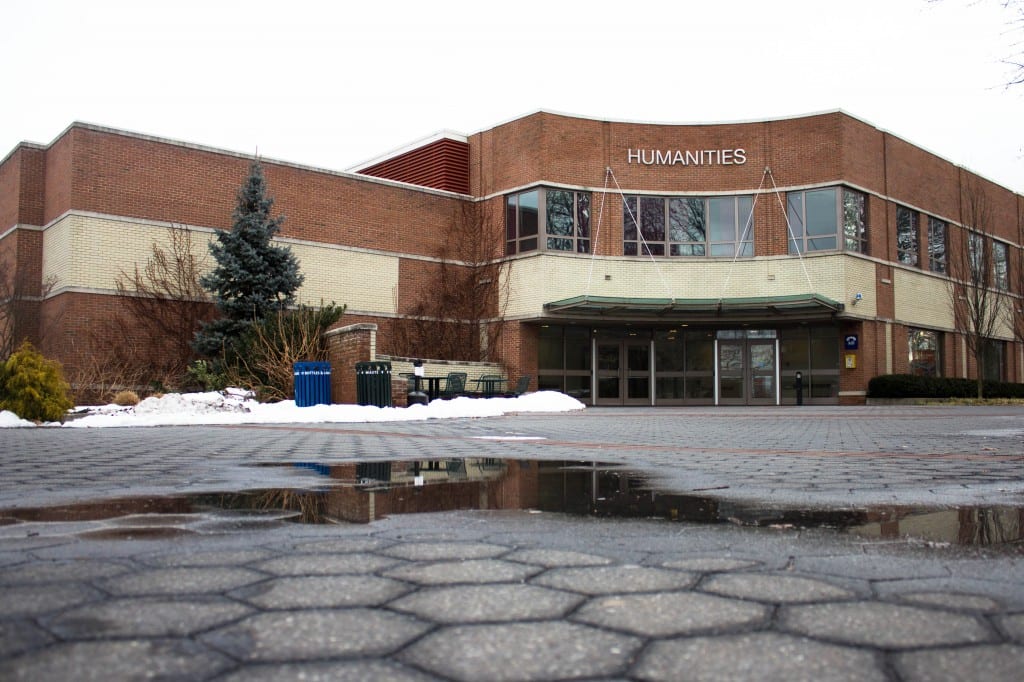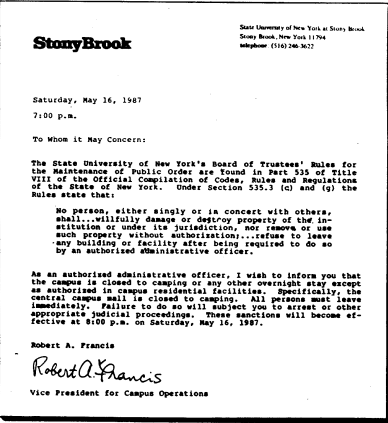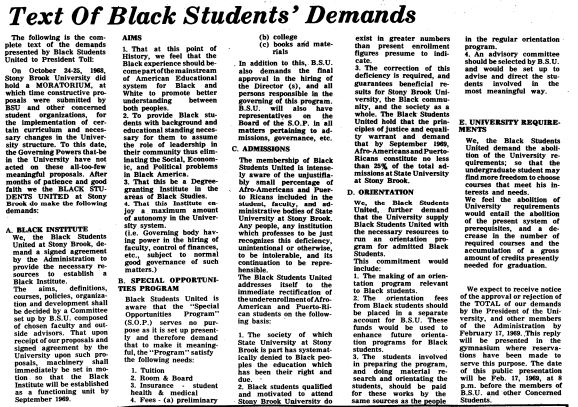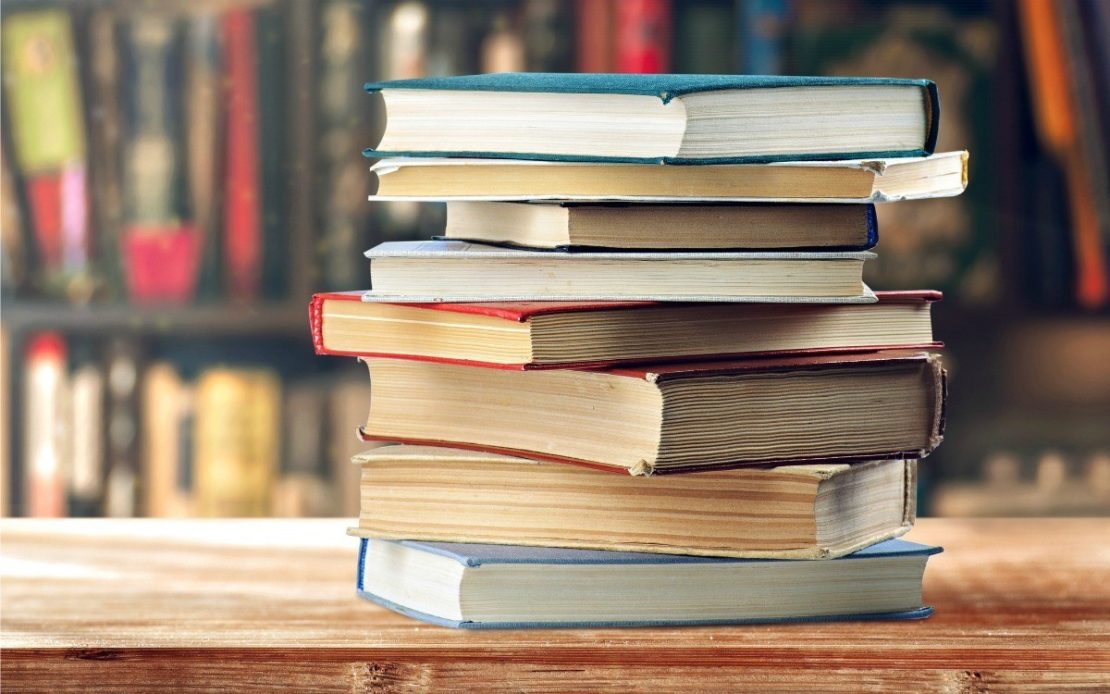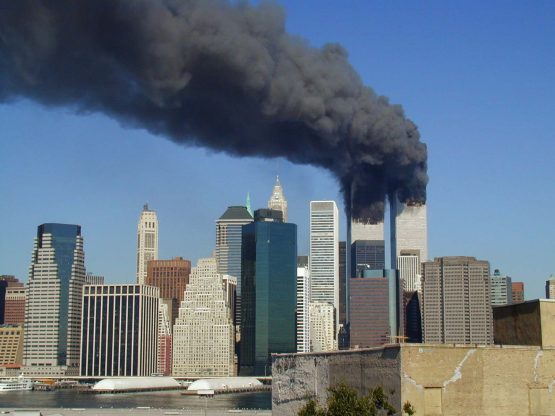
Kelcie Eberharth is the archivist at The Statesman and an editor at Stony Brook’s Undergraduate History Journal. This month, she examined The Statesman‘s coverage of the Sept. 11 attacks in the days, weeks and years following.
Sept. 11, 2021 was a momentous day for people around the country.
Almost 3,000 people lost their lives due to a terrorist plot carried out by a Muslim-extremist group on Sept. 11, 2001. On the 20th anniversary of this tragedy, people came together to mourn the loss of family, friends and loved ones.
While the effects of the violence that occurred could be felt worldwide, it hit Stony Brook campus especially hard. Students searched for missing family members, feared attacks would hit closer to home and came together to help those in need. As time dragged on, Stony Brook students, faculty and staff continued to keep 9/11 in their forethoughts. Protests and rallies were held and donations made.
The Statesman took up the responsibility of not only covering the events that followed 9/11 in the city, but also on campus. Countless articles have been written since that fateful day to keep the student body informed on what actions both the campus and government were taking.
In the first edition published after the attacks on 9/11, Statesman editors and writers plastered the front page with coverage of the events that followed 10:28 a.m. when the North Tower fell.
Local students were frantically trying to get a hold of their families to ensure their loved ones were safe. Christopher Latham, in “After Terrorist Strike, Students Search for Loved Ones,” reported on several students’ attempts to contact family members that were working in the towers and first responders. While these students’ loved ones were safe, the fear they experienced left them speechless and scared for what was to happen next.
Another article by Chrisopher Latham, “Nation’s Terror Touches Stony Brook,” highlights the effort Stony Brook took in keeping students safe and assisting the local community. The school added extra security to campus to ensure the safety of students, administration, staff and faculty. A blood drive that was being held on 9/11 had such a large turnout that another drive had to be scheduled later that week. Then-Stony Brook President Shirley Strum Kenny attended prayer vigils being held by various denominations and reminded the people of Stony Brook the importance of standing together.
Kelly Brown reported on a panel discussion that was a part of the “Divided We Fall” series. “Ambassador Lectures on Unity” recounts the words of panel members such as Stony Brook President Kenny, Deputy Chief of University Police Douglas Little, former Bureau Chief of ABC News in Lebanon Bill Zimmerman and other prominent members of the local community. Yassin El-Ayouty, a political science professor of the time, expressed the necessity of continuing to live without fear. All of the members stood firm in one stance: the importance for peaceful resolutions by the government and peaceful actions by citizens.
In the same issue, Binal Zaveri covered the need for religious tolerance in “Muslims Rally for Peace and Tolerance.” Coordinators of the rally urged Stony Brook to be a leader to other schools on understanding due to its diverse community. Sister Sanna Nadim, Muslim Chaplain of the Islamic Society of North America, reminded those in attendance that Islam stands for peace, not violence.
“Preserving Iraq’s Lost Treasures: SBU Professors Rebuild Universities, Receive $4.1 Million Federal Grant” by Patricia McCabe dives into the University’s work to help rebuild Iraq after the U.S. invasion. Stony Brook was awarded a massive grant to help establish a stronger education field, starting in Mosul and Baghdad Universities. Elizabeth Stone, a Stony Brook professor of anthropology, was selected to lead professors from universities such as Oxford and Columbia in this effort.
Sept. 11, 2001 was a reminder that Stony Brook is not just a school, but a community. The actions taken by students, faculty, staff and administration in the hours, days, weeks and years that followed demonstrated how the University can come together in times of tragedy.
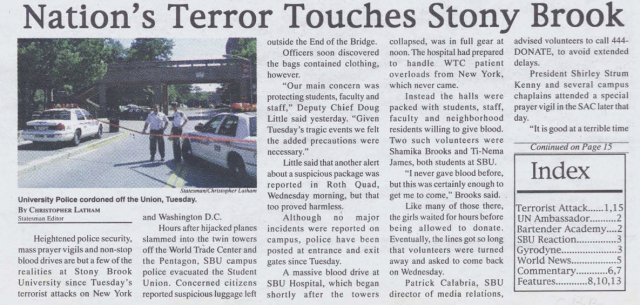
Heightened police security, mass prayer vigils and non-stop blood drives are but a few of the realities at Stony Brook University since Tuesday’s terrorist attacks on New York and Washington D.C.
Hours after hijacked planes slammed into the twin towers off the World Trade Center and the Pentagon, SBU campus police evacuated the Student Union. Concerned citizens reported suspicious luggage left outside the End of the Bridge.
Officers soon discovered the bags contained clothing, however.
“Our main concern was protecting students, faculty and staff,” Deputy Chief Doug Little said yesterday, “Given Tuesday’s tragic events we felt the added precautions were necessary.”
Little said that another alert about a suspicious package was reported in Roth Quad, Wednesday morning, but that too proved harmless.
Although no major incidents were reported on campus, police have been posted at entrance and exit gates since Tuesday.
A massive blood drive at Sbu Hospital, which began shortly after the towers collapsed, was in full gear at noon. The hospital had prepared to handle WTC patient overloads from New York, which never came.
Instead the halls were packed with students, staff, faculty and neighborhood residents willing to give blood. Two such volunteers were Shamika Brooks and Ti-Nema James, both students at SBU.
“I never gave blood before, but this was certainly enough to get me to come,” Brooks said.
Like many of those there, the girls waited hours before being allowed to donate. Eventually, the lines got so long that volunteers were turned away and asked to come back on Wednesday.
Patrick Calabria, SBU director of media relations, advised volunteers to call 444-DONATE, to avoid extended delays.
President Shirley Strum Kenny and several campus chaplains attended a special prayer vigil in the SAC later that day.
“It is good at a terrible time like this to be together,” Kenny said.
She assured the audience that SBU had taken proper precautions to house all those unable to get back to the city, and that a crisis prevention center had been established for anyone in need of counseling. Kenny also made a plea for blood donors, especially those with Type O blood, the universal donor.
“We are a diverse community, and in our diversity is our strength,” she said. “We must, as a community, be strong in the face of such a terrible tragedy.”
Jewish chaplain Joseph Topek, Muslim chaplain Sanaa Nadim, Protestant chaplain Clark Berge as well as Catholic chaplains Sister Margaret Landry and Father John Fitzgerald all spoke at the ceremony.
“As the news trickled in this morning I think we all sat in disbelief,” he Topek said. “Disbelief that there might be human beings amongst us who could do such terrible things. Take so many lives.”
After a series of prayers and reflections by other chaplains, Nadim offered her sympathies to those impacted by the attacks.
“I give my condolences to the families who lost loved ones today, and I share the condemnation of all the Muslim and Arab world,” she said.
Fred Preston, the vice president for student affairs, spoke last. He called the assaults a consequence of cross-cultural conflict run amok, and praised the “beauty” of the cross-cultural community here at SBU.
“It was all too real,” he said. “The shock and disorientation will last for a few days before it really hits home.”
Kenny issued the following quote after the prayer vigil:
“I was of course devastated by the bombing and very fearful that our faculty, staff, and students will be involved in the losses. It was such a stunning, crazy act that I don’t know if I really can absorb it yet.
But I know that it is very important for us not to start making conclusions about who did it, and certainly it’s important for us to stay together as a community and understand that people at Stony Brook are suffering whatever their background, and that we really have to help each other now as much as ever before.”
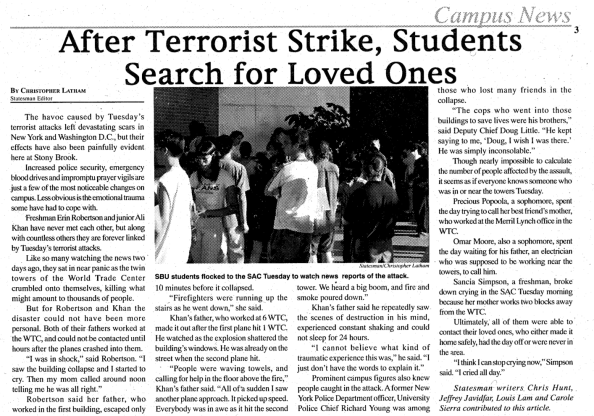
The havoc caused by Tuesday’s terrorist attacks left devastating scars in New York and Washington D.C., but their effects have also been painfully evident here at Stony Brook.
Increased police security, emergency blood drives and impromptu prayer vigils are just a few of the most noticeable changes on campus. Less obvious is the emotional trauma some have had to cope with.
Freshman Erin Robertson and junior Ali Khan have never met each other, but along with countless others they are forever linked by Tuesday’s terrorist attacks.
Like so many watching the news two days ago, they sat in near panic as the twin towers of the World Trade Center crumbled onto themselves, killing what might amount to thousands of people.
But for Robertson and Khan the disaster could not have been more personal. Both of their fathers worked at the WTC, and could not be contacted until hours after the planes crashed into them.
“I was in shock,” said Robertson. “I saw the building collapse and I started to cry. Then my mom called around noon telling me he was all right.”
Robertson said her father, who worked in the first building, escaped only 10 minutes before it collapsed.
“Firefighters were running up the stairs as he went down,” she said.
Khan’s father, who worked at 6 WTC, made it out after the first plane hit 1 WTC. He watched as the explosion shattered the building’s windows. He was already on the street when the second plane hit.
“People were waving towels and calling for help in the floor above the fire,” Khan’s father said. “All of a sudden I saw another plane approach. It picked up speed. Everybody was in awe as it hit the second tower. We heard a big boom, and fire and smoke poured down.”
Khan’s father said he repeatedly saw the scenes of destruction in his mind, experienced constant shaking and could not sleep for 24 hours.
“I cannot believe what kind of traumatic experience this was,” he said. “I just don’t have the words to explain it.”
Prominent campus figures also knew people caught in the attack. A former New York Police Department officer, University Police Chief Richard Young was among those who lost many friends in the collapse.
“The cops who went into those buildings to save lives were his brothers,” said Deputy Chief Doug Little. “He kept saying to me, ‘Doug, I wish I was there.’ He was simply inconsolable.”
Though nearly impossible to calculate the number of people affected by the assault, it seems as if everyone knows someone who was in or near the towers Tuesday.
Precious Popoola, a sophomore, spent the day trying to call her best friend’s mother, who worked at the Merril Lynch office in the WTC.
Omar Moore, also a sophomore, spent the day waiting for his father, an electrician who was supposed to be working near the towers, to call him.
Sancia Simpson, a freshman, broke down crying in the SAC Tuesday morning because her mother works two blocks away from the WTC.
Ultimately, all of them were able to contact their loved ones, who either made it home safely, had the day off or were never in the area.
“I think I can stop crying now,” Simpson said. “I cried all day.”
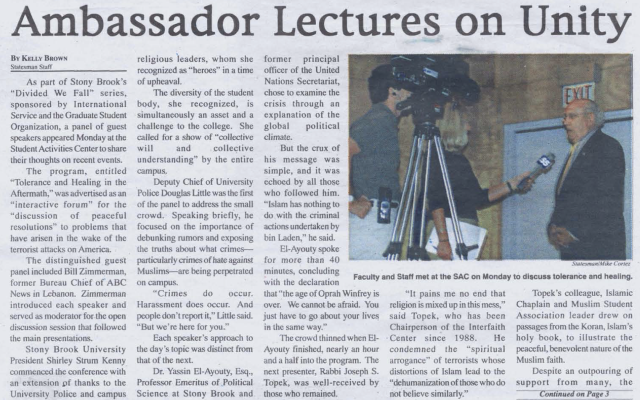
As part of Stony Brook’s “Divided We Fall” series, sponsored by International Service and the Graduate Student Organization, a panel of guest speakers appeared Monday at the Student Activities Center to share their thoughts on recent events.
The program, entitled “Tolerance and Healing in the Aftermath,” was advertised as an “interactive forum” for the “discussion of peaceful resolutions” to problems that have arisen in the wake of the terrorist attacks on America.
The distinguished guest panel included Bill Zimmerman, former Bureau Chief of ABC News in Lebanon. Zimmerman introduced each speaker and served as moderator for the open discussion session that followed the main presentations.
Stony Brook University President Shirley Strum Kenny commenced the conference with an extension of thanks to the University Police and campus religious leaders, whom she recognized as “heroes” in a time of upheaval.
The diversity of the student body, she recognized, is simultaneously an asset and a challenge to the college. She called for a show of “collective will and collective understanding” by the entire campus.
Deputy Chief of University Police Douglas Little was the first of the panel to address the small crowd. Speaking briefly, he focused on the importance of debunking rumors and exposing the truths about what crimes- particularly crimes of hate against Muslims- are being perpetrated on campus.
“Crimes do occur. Harassment does occur. And people don’t report it,” Little said. “But we’re here for you.”
Each speaker’s approach to the day’s topic was distinct from that of the next.
Dr. Yassin El-Ayouty, Esq., Professor Emeritus of Political Science at Stony Brook and former principal officer of the United Nations Secretariat, chose to examine the crisis through an explanation of the global political climate.
But the crux of his message was simple, and it was echoed by all those who followed him. “Islam has nothing to do with the criminal actions undertaken by bin Laden,” he said.
El-Ayouty spoke for more than 40 minutes, concluding with the declaration that “the age of Oprah Winfrey is over. We cannot be afraid. You just have to go about your lives in the same way.”
The crowd thinned when El-Ayouty finished an hour and a half into the program. The next presenter, Rabbi Joseph S. Topek, was well-received by those who remained.
“It pains me no end that religion is mixed up in this mess,” said Topek, who has been Chairperson of the Interfaith Center since 1988. He condemned the “spiritual arrogance” of terrorists whose distortions of Islam lead to the “dehumanization of those who do not believe similarly.”
Topek’s colleague, Islamic Chaplain and Muslim Student Association leader drew on passages from the Koran, Islam’s holy book, to illustrate the peaceful, benevolent nature of the Muslim faith.
Despite an outpouring of support from many, the terrorist attack has brought a tinge of prejudice and intolerance to the surface of American society. “It’s been an uphill battle for many Muslims these past ten days,” said Nadim.
Ambassador Harsh Bhasin, a visiting professor of International Relations, asserted that this bigotry is precisely what the terrorists want. According to him, if we promote “tolerance and healing in the aftermath, we defeat the long term goal of the terrorists.”
During the question and answer session, students and other members of the community seized the opportunity to be heard. One graduate student expressed concern over racial profiling, while another woman said she believed there was a deep hatred of Americans in the Arab world. The panel members fielded comments and questions deftly, and the atmosphere was one of control and mutual understanding.
Although no fast solutions were offered, the discussions that resulted were, in the words of one student, “open, honest, and invaluable.”
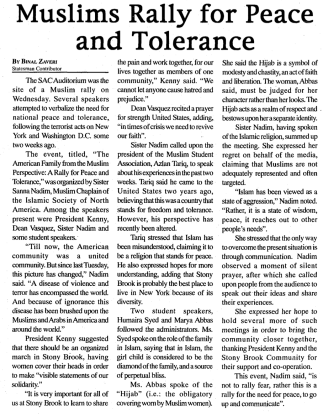
The SAC Auditorium was the site of a muslim rally on Wednesday. Several speakers attempted to verbalize the need for national peace and tolerance, following the terrorist acts on New York and Washington D.C. some two weeks ago.
The event, titled, “The American Family from the Muslim Perspective: A Rally for Peace and Tolerance,” was organized by Sister Sanna Nadim, Muslim Chaplain of the Islamic Society of North America. Among the speakers present were President Kenny, Dean Vasquez, Sister Nadim and some student speakers.
“Till now, the American community was a united community. But since last Tuesday, this picture has changed,” Nadim said. “A disease of violence and terror has encompassed the world. And because of ignorance this disease has been brushed upon the Muslims and Arabs in America and around the world.”
President Kenny suggested that there should be an organized march in Stony Brook, having women cover their heads in order to make “visible statements of our solidarity.”
“It is very important for all of us at Stony Brook to learn to share the pain and work together, for our lives together as members of one community,” Kenny said. “We cannot let anyone cause hatred and prejudice.”
Dean Vasquez recited a prayer for strength United States, adding, “in times of crisis we need to revive our faith”.
Sister Nadirn called upon the president of the Muslim Student Association, Azlan Tariq, to speak about his experiences in the past two weeks. Tariq said he came to the United States two years ago, believing that this was a country that stands for freedom and tolerance. However, his perspective has recently been altered.
Tariq stressed that Islam has been misunderstood, claiming it to be a religion that stands for peace. He also expressed hopes for more understanding, adding that Stony Brook is probably the best place to live in New York because of its diversity.
Two student speakers, Humaira Syed and Marya Abbas followed the administrators. Ms. Syed spoke on the role of the family in Islam, saying that in Islam, the girl child is considered to be the diamond of the family, and a source of perpetual bliss.
Ms. Abbas spoke of the “Hijab” (i.e.: the obligatory covering worn by Muslim women). She said the Hijab is a symbol of modesty and chastity, an act of faith and liberation. The woman, Abbas said, must be judged for her character rather than her looks. The Hijab acts as a realm of respect and – bestows upon her a separate identity.
Sister Nadim, having spoken of the Islamic religion, summed up the meeting. She expressed her regret on behalf of the media, claiming that Muslims are not adequately represented and often targeted.
“Islam has been viewed as a state of aggression,” Nadim noted. “Rather, it is a state of wisdom, peace, it reaches out to other people’s needs”.
She stressed that the only way to overcome the present situation is through communication. Nadim observed a moment of silent prayer, after which she called upon people from the audience to speak out their ideas and share their experiences.
She expressed her hope to hold several more of such meetings in order to bring the community closer together, thanking President Kenny and the Stony Brook Community for their support and co-operation.
This event, Nadim said, “is not to rally fear, rather this is a rally for the need for peace, to go up and communicate”.
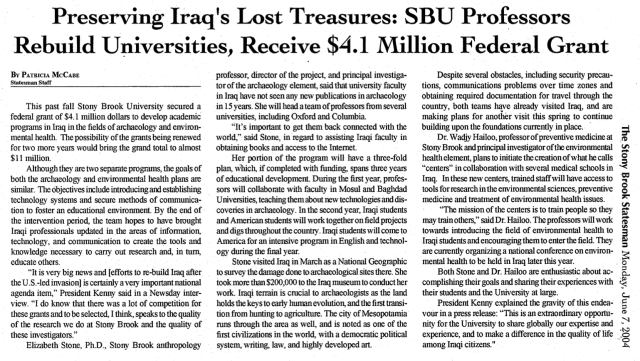
This past fall Stony Brook University secured a federal grant of $4.1 million dollars to develop academic programs in Iraq in the fields of archaeology and environmental health. The possibility of the grants being renewed for two more years would bring the grand total to almost $11 million.
Although they are two separate programs, the goals of both the archaeology and environmental health plans are similar. The objectives include introducing and establishing technology systems and secure methods of communication to foster an educational environment. By the end of the intervention period, the team hopes to have brought Iraqi professionals updated in the areas of information, technology, and communication to create the tools and knowledge necessary to carry out research and, in turn, educate others.
“It is very big news and [efforts to re-build Iraq after the U.S.-led invasion] is certainly a very important national agenda item,” President Kenny said in a Newsday interview. “I do know that there was a lot of competition for these grants and to be selected, I think, speaks to the quality of the research we do at Stony Brook and the quality of these investigators.”
Elizabeth Stone, Ph.D., Stony Brook anthropology professor, director of the project, and principal investigator of the archaeology element, said that university faculty in Iraq have not seen any new publications in archaeology in 15 years. She will head a team of professors from several universities, including Oxford and Columbia.
“It’s important to get them back connected with the world,” said Stone, in regard to assisting Iraqi faculty in obtaining books and access to the Internet.
Her portion of the program will have a three-fold plan, which, if completed with funding, spans three years of educational development. During the first year, professors will collaborate with faculty in Mosul and Baghdad Universities, teaching them about new technologies and discoveries in archaeology. In the second year, Iraqi students and American students will work together on field projects and digs throughout the country. Iraqi students will come to America for an intensive program in English and technology during the final year.
Stone visited Iraq in March as a National Geographic to survey the damage done to archaeological sites there. She took more than $200,000 to the Iraq museum to conduct her work. Iraqi terrain is crucial to archaeologists as the land holds the keys to early human evolution, and the first transition from hunting to agriculture. The city of Mesopotamia runs through the area as well, and is noted as one of the first civilizations in the world, with a democratic political system, writing, law, and highly developed art.
Despite several obstacles, including security precautions, communications problems over time zones and obtaining required documentation for travel through the country, both teams have already visited Iraq, and are making plans for another visit this spring to continue building upon the foundations currently in place.
Dr. Wadjy Hailoo, professor of preventive medicine at Stony Brook and principal investigator of the environmental health element, plans to initiate the creation of what he calls “centers” in collaboration with several medical schools in Iraq. In these new centers, trained staff will have access to tools for research in the environmental sciences, preventive medicine and treatment of environmental health issues.
“The mission of the centers is to train people so they may train others,” said Dr. Hailoo. The professors will work towards introducing the field of environmental health to Iraqi students and encouraging them to enter the field. They are currently organizing a national conference on environmental health to be held in Iraq later this year.
Both Stone and Dr. Hailoo are enthusiastic about accomplishing their goals and sharing their experiences with their students and the University at large.
President Kenny explained the gravity of this endeavour in a press release: “This is an extraordinary opportunity for the University to share globally our expertise and experience, and to make a difference in the quality of life among Iraqi citizens.”







